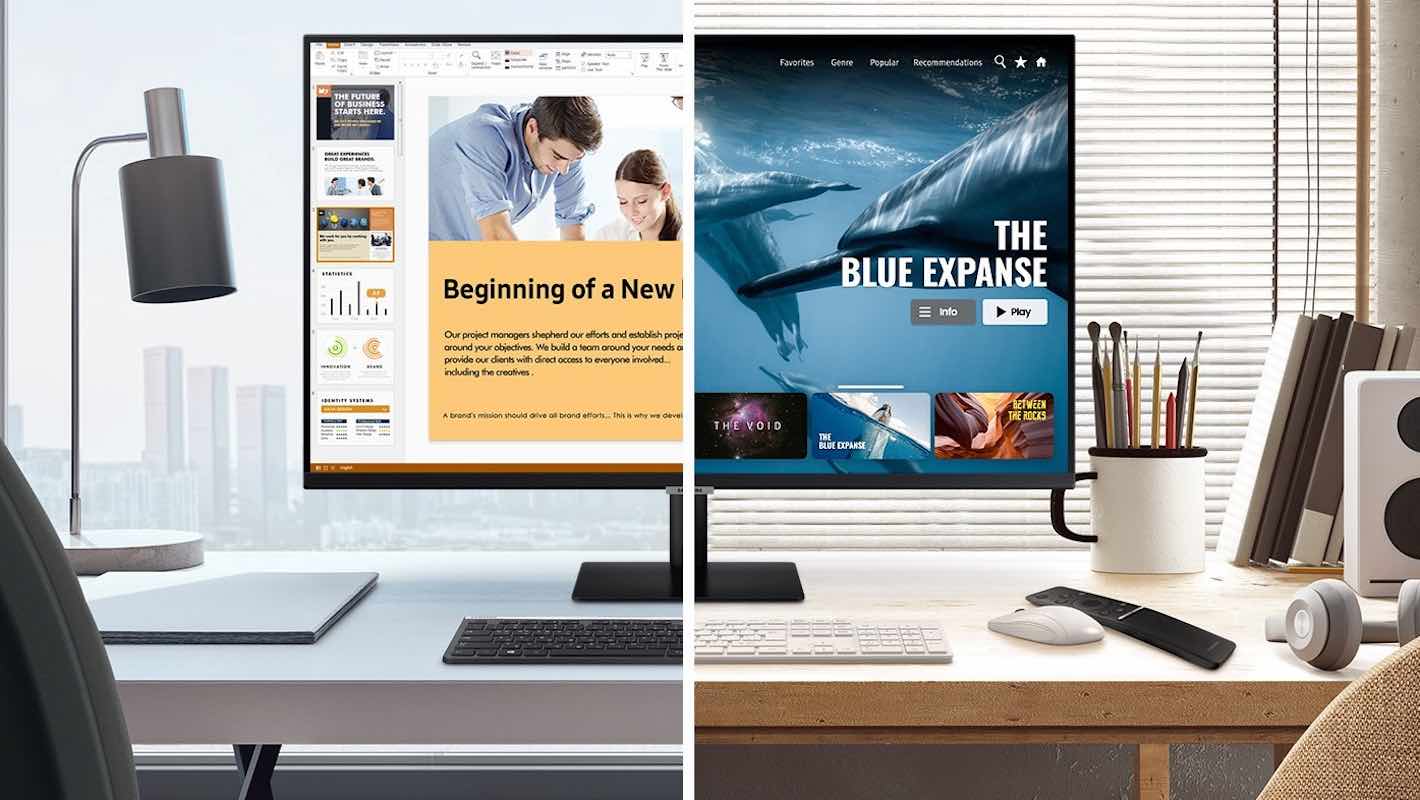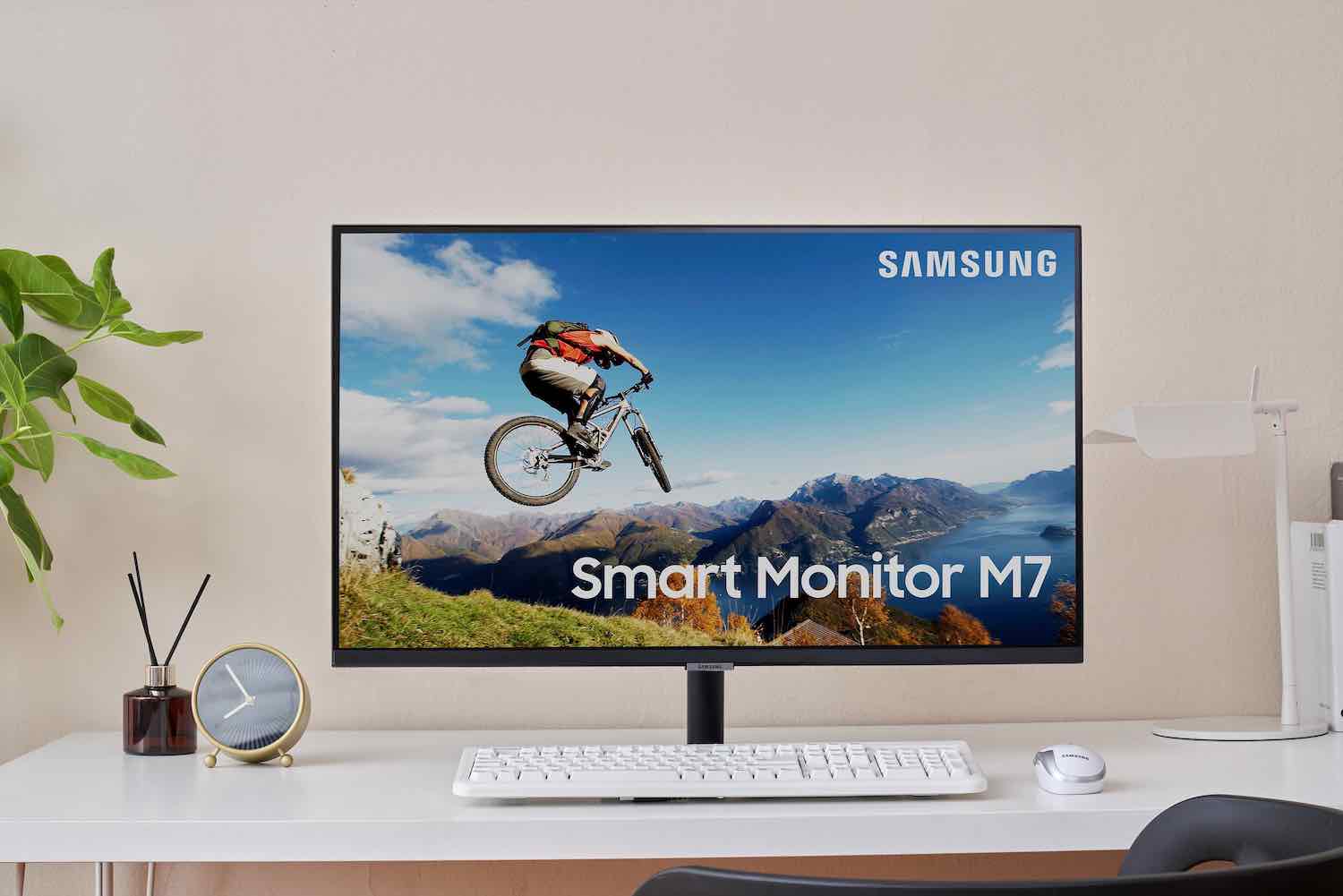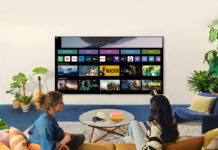
When you’re upgrading to a new display, do you choose a computer monitor or TV? It can be hard to pick one or the other when they both have such great features, but the key to making your choice easy is knowing the difference between a smart monitor and a smart TV and deciding how you’ll use the display on a day to day basis.
Smart monitor or smart TV?
When choosing between a smart monitor and a smart TV the main options you’ll want to look at are size, refresh rate, inputs, picture quality, and sound quality. I just tested out Samsung smart monitors that double as both a monitor and a TV, so take a look at my review if you’re interested in seeing how the Samsung M5, M7, and M8 smart monitors offer the best of both monitor and smart TV functions.
Range of monitor and TV sizes
The average size of a smart TV is 55 inches. You can find smaller smart TVs, with some models as small as 24 inches. For a smart monitor, the average size is 27 inches, and you can find smart monitors that are as large as 32 inches.
One of the bonuses to a smart monitor is the ultra-wide field of view. Some models have 178-degree horizontal and vertical viewing angles so you get a clear view from every seat in the room.
Refresh rate and response time

When gaming, refresh rate is one of the most important features on your display. The average refresh rate on a smart TV is 60Hz, but you’ll also find smart TVs with a 120Hz refresh rate. While response time will vary, you’ll find smart TVs average around 8ms. Some smart TVs also have technology built-in that will reduce any screen tearing or motion blur when gaming or watching action-packed movies and sports.
The average refresh rate on a smart monitor is 60Hz, but the response time is slightly lower at 4.5ms. That will make gaming a breeze when connecting gaming consoles or streaming MMO games.
Inputs on a smart TV vs smart monitor
When you have a smart TV you’ll connect all of your external devices including extra media streamers, cable boxes, Blu-ray players, and gaming consoles. Many of the latest TVs have 3 or 4 HDMI ports including an HDMI eARC to connect your sound bar or home theatre speaker system. You’ll also find TVs offer a USB and digital optical port.
Smart monitors have quite a few inputs as well, but they won’t offer as many as a smart TV. Because a monitor is meant to connect to your computer, you’ll find they have one or two HDMI ports or a micro-HDMI port and a USB input.
Picture quality on monitors vs TVs
A smart TV has a resolution of 1080p Full HD, 4K, or 8K. Smart monitors also offer Full HD or 4K resolution. While the general rule is that a smart TV offers better colour volume, higher brightness, and has technology on board that boosts colour and picture quality, some smart monitors can offer that as well. Take Samsung smart monitors as an example – some types have 4K resolution and 99% sRGB colour volume so it can produce millions of colour combinations.
Sound quality built into smart monitors and smart TVs

Smart TVs have ultra-thin panels that place speakers in the back or underneath the screen. Smart monitors also have extremely thin panels, so speaker placement is the same as a TV. Both will provide great audio and both will have technology like Adaptive Sound to adjust audio output based on the content you’re watching or playing.
You may want to enhance your audio output so you can enjoy louder music, movies, or gaming. You can easily connect speakers or a sound bar to either and enjoy clearer dialogue and enhanced sound effects.
Streaming apps on one screen
The beauty of a smart monitor is that it has an operating system like a smart TV. You’ll find all of your favourite streaming apps right on the main screen, and both will have links to direct you to different functions including AirPlay or your inputs.
A smart monitor will also have a spot to access your PC or plug in your Macbook. With a smart monitor like the Samsung smart monitor, you can use Workmode to access all of your PC apps like Word or Excel without actually connecting to your PC. Both a smart monitor and a smart TV also have a remote control you can use to control volume, change apps or channels, or switch to a different mode.
Some smart TVs will offer voice control and can connect to your voice assistant. Samsung smart monitors offer voice control too, with access to Bixby as well.
The key differences between a smart monitor and smart TV
As you can see, there aren’t a lot of differences between a smart monitor and a smart TV. A smart TV is available in larger sizes and has more inputs, but a smart monitor is available in sizes up too 32 inches and still offers at least two HDMI connections.
Smart TVs have unique tech on board to enhance picture quality, but a smart monitor is smaller so picture quality will also be clear and sharp. You also have wide viewing angles for gaming and watching movies.
The choice between one or the other will depend on what your goals are for your display. If you plan on connecting it to your computer permanently or you want to use it as a second display for your laptop, you may opt for a smart monitor. If you would just like to watch movies and TV on a big screen and you don’t need the computer component, you may want to choose a smart TV. Just keep in mind that you can watch your favourite streaming apps on both, and they both come with a remote so they are easy to control.
You can find both smart monitors and smart TVs at Best Buy right now.



